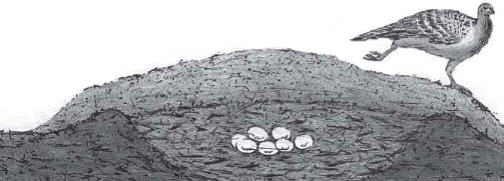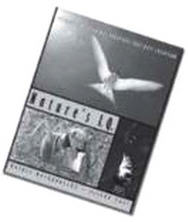All animals possess such innate instincts which
control their eating, defending and mating
behaviour. A great number of these behavioural
patterns do not merely consist of one single
phase, but involve a range of behavioral steps
that must be always present in order to achieve
successful action. This represents a serious, if
not lethal, threat against the Darwinian Theory.
Incubator from own material
The East Australian mallee fowl (Leipoa ocellata) hatches its eggs in a quite unusual way. First, mallee fowl parents dig a hole with their strong legs fifteen feet wide and three feet deep. During wintertime, they gather twigs and leaves from within a radius of fifty meters and amass them in the hole. When the material thus gathered has got thoroughly soaked in the rain, they cover the whole thing with a layer of sandy earth half a meter thick. This is how the mallee builds its crater like nest, which towers nearly one and half meter high.
The mallee fowl hen lays her eggs on rotting leaves in the egg chamber within the nest mound, and then the male buries the egg chamber. Starting in the spring, for three to four months, the hen comes once a week to lay one egg each time, then leaves the nest. During the long nine month period of hatching the cock takes care of the right incubation temperature.
Most species of birds hatch their eggs with the warmth of their own body. However, this case is totally different. The eggs of mallee fowl hatch by the warmth of the hill, as the rotting plant matter piled up inside generates heat which hatches the eggs. From time to time the male sticks his bill into the hill to check the temperature of the soil. He is able to measure the temperature most probably with his tongue or oral cavity. He maintains the temperature of the mound functioning as an incubator at 93.2 degrees Fahrenheit (34 degrees centigrade)with incredible precision. He allows a maximum fluctuation of 1.8 degrees (1 degree Celsius) inside the mound, although in that region daily and yearly temperatures vary considerably.
If the eggs would overheat, he assiduously removes a layer of sand from the top of the hill to emit extra heat. Alternatively, if the mound has to be protected from excessive sunshine, then under such circumstances he scratches more soil onto the mound.
When outside temperature turns colder, he removes the upper layers of the hill during the day so that the sun shines right on the middle of the nest. But in the evening he covers it again to retain the heat. Nestlings hatch at different times and break the eggshell with their strong legs. Miraculously, they do not suffocate inside the mound, but keeping their bill and eyes tightly shut they begin to dig themselves out of the hill. They struggle hard for five to ten minutes to make way upwards, merely a few centimetres, then they rest for about an hour and start everything again. It might take them 2–15 hours to get to the surface of the mound, where after getting out they take a deep breath and open their eyes. Afterwards, they waddle or roll down the hatching mound and rush into the surrounding scrubland.
These youngs are some of the most developed chickens of the avifauna. They are in full feather and after hatching they run well within an hour. After a day they are able to fly and eat on their own. They never meet their parents and learn from no one how to build a mound or how to maintain its temperature. Still, when they “come of age,” they behave exactly as their parents did.
Beyond hen witted explanations

The mallee fowl belongs to the family of incubator birds (Megapodiidae). All the bird species belonging to this taxonomic family are well known for utilizing external heat source to hatch their eggs. Evolutionary science journals assume that this hatching method evolved in some way or another from the traditional, “sitting on the eggs” hatching due to small advancement in succession. Nevertheless, they are unable to give any kind of theoretical explanation for this gradual evolvement, which would be in line with the principles of their theory.
Just think it over! Would it be possible to omit any of the afore mentioned elements and still have the eggs hatched? Surely not, because all these particular anatomical characteristics and instinctive behavioral programs are needed at the very same time, so that the following generations of birds are able to come into existence. This is the reason why one cannot draw a line of progressive development, consisting of gradual, numerous little changes, leading from the “heating with body” to the “mound builder” system. By the time the eggs are laid and hid in the ground, all the other elements (physical characteristics and instincts of the mallee fowl) should be present, otherwise the temperature of eggs would not be maintained and the embryos inside would perish.
Thus the mallee fowl’s method of hatching is an irreducible system, as the process works only if each jigsaw piece of the behavioral chain is in its proper place. It is impossible to have all the manifold elements so much coordinated and have them simultaneously present. The simultaneous emergence of so many, coordinated elements without conscious control, merely by undirected chance mutation is utterly impossible.
Therefore the origin of the mallee fowl is such a riddle that has only one particular solution: this bird, with all its anatomical features and instinctive behavior, was devised by a higher intelligence. Moreover, the “sitting on the eggs” and the “mound building” incubation techniques most likely manifested at the same time as parts of a comprehensive, superior plan.
Excerpts from Nature’s I.Q. by Torchlight Publications. Visit www.naturesiq.com or www.torchlight.com for similar books.
In order to understand more deeply why evolutionary theory does not stand its ground regarding the origin of mallee fowl’s “hatching strategy,” let us take into consideration what all is needed for the successful hatching of the nestlings.
From the hen’s point of view:
• Coming back regularly and laying the eggs on the appropriate spot.
From the cock’s point of view:
• Knowledge about the material and structure of the hill.
• Building of the hatching mound.
• Specific organ to check the temperature of the soil.
• Sophisticated instinct to ensure a constant temperature inside the hatching mound.
From the chickens’ point of view:
• Appropriate instinctive behavior regarding what to do after hatching.
• Adequate anatomical build to have the strength to dig themselves out from the mound and to survive on their own.
• Instinctive behavioral patterns from their birth on, making them capable for breeding and nurturing.

